run flat JEEP GRAND CHEROKEE 2013 Owner handbook (in English)
[x] Cancel search | Manufacturer: JEEP, Model Year: 2013, Model line: GRAND CHEROKEE, Model: JEEP GRAND CHEROKEE 2013Pages: 408, PDF Size: 3.21 MB
Page 49 of 408

Advanced Front Air Bags and Supplemental
Driver Side Knee Air Bag are designed to
provide additional protection by supplementing
the seat belts in certain frontal collisions de-
pending on several factors, including the sever-
ity and type of collision. Advanced Front Air
Bags are not expected to reduce the risk of
injury in rear, or side collisions.
The Advanced Front Air Bags and Supplemen-
tal Driver Side Knee Air Bag will not deploy in all
frontal collisions, including some that may pro-
duce substantial vehicle damage — for ex-
ample, some pole collisions, truck underrides,
and angle offset collisions. On the other hand,
depending on the type and location of impact,
Advanced Front Air Bags may deploy in crashes
with little vehicle front-end damage but that
produce a severe initial deceleration.
The side air bags will not deploy in all side
collisions. Side air bag deployment will depend
on the severity and type of collision.
Because air bag sensors measure vehicle decel-
eration over time, vehicle speed and damage bythemselves are not good indicators of whether or
not an air bag should have deployed.
Seat belts are necessary for your protection in
all collisions, and also are needed to help keep
you in position, away from an inflating air bag.
The ORC monitors the readiness of the elec-
tronic parts of the air bag system whenever the
ignition switch is in the START or ON/RUN
position. If the key is in the LOCK position, in the
ACC position, or not in the ignition, the air bag
system is not on and the air bags will not inflate.
The ORC contains a backup power supply
system that may deploy the air bags even if the
battery loses power or it becomes disconnected
prior to deployment.
Also, the ORC turns on the Air Bag
Warning Light in the instrument
panel for approximately four to
eight seconds for a self-check
when the ignition is first turned to
the ON/RUN position. After the self-check, the
Air Bag Warning Light will turn off. If the ORC
detects a malfunction in any part of the system, it turns on the Air Bag Warning Light, either
momentarily or continuously. A single chime will
sound if the light comes on again after initial
startup.
It also includes diagnostics that will illuminate
the instrument cluster Air Bag Warning Light if a
malfunction is noted that could affect the air bag
system. The diagnostics also record the nature
of the malfunction.
WARNING!
Ignoring the Air Bag Warning Light in your
instrument panel could mean you won’t have
the air bags to protect you in a collision. If the
light does not come on as a bulb check when
the ignition is first turned on, stays on after
you start the vehicle, or if it comes on as you
drive, have an authorized dealer service the
air bag system immediately.
45
Page 52 of 408
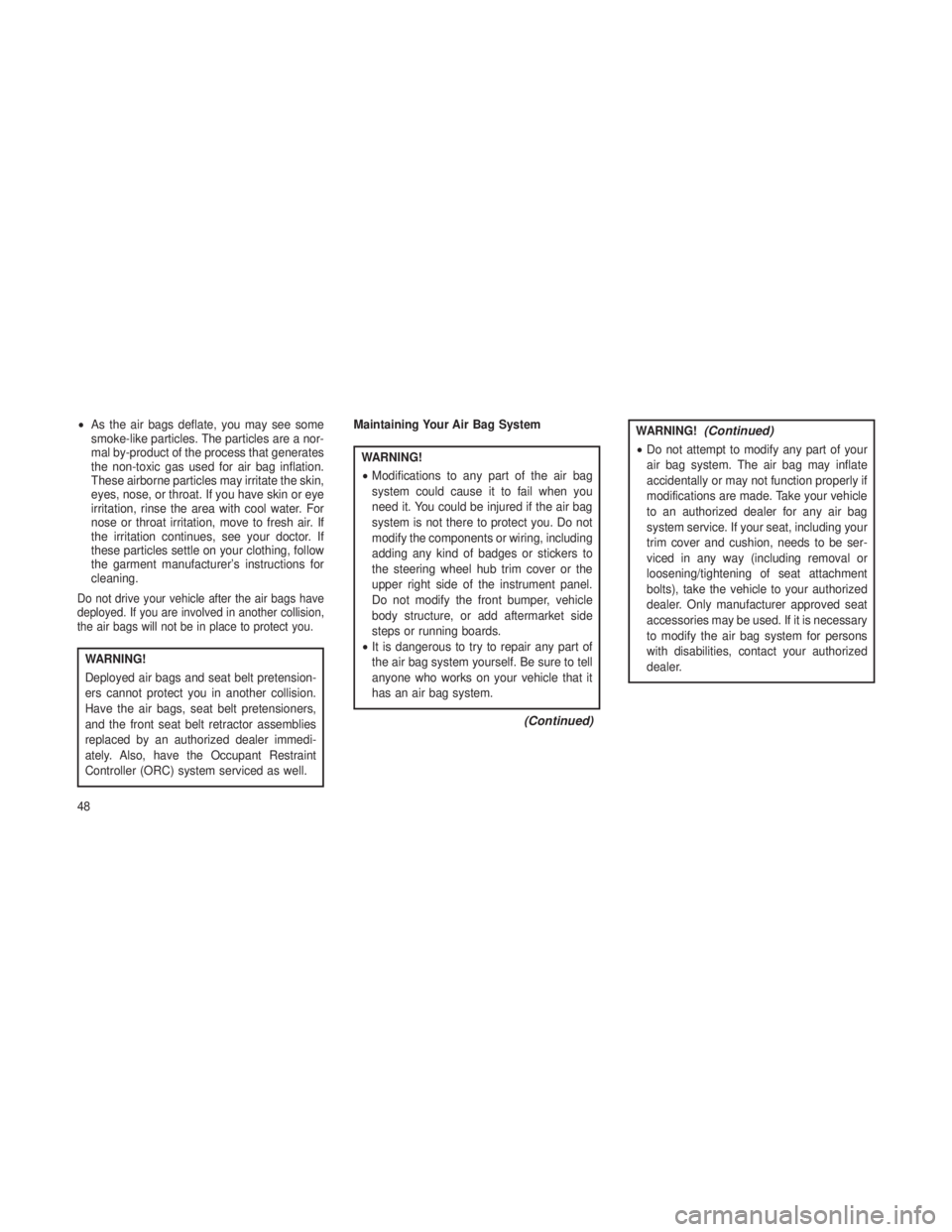
•As the air bags deflate, you may see some
smoke-like particles. The particles are a nor-
mal by-product of the process that generates
the non-toxic gas used for air bag inflation.
These airborne particles may irritate the skin,
eyes, nose, or throat. If you have skin or eye
irritation, rinse the area with cool water. For
nose or throat irritation, move to fresh air. If
the irritation continues, see your doctor. If
these particles settle on your clothing, follow
the garment manufacturer’s instructions for
cleaning.
Do not drive your vehicle after the air bags have
deployed. If you are involved in another collision,
the air bags will not be in place to protect you.
WARNING!
Deployed air bags and seat belt pretension-
ers cannot protect you in another collision.
Have the air bags, seat belt pretensioners,
and the front seat belt retractor assemblies
replaced by an authorized dealer immedi-
ately. Also, have the Occupant Restraint
Controller (ORC) system serviced as well. Maintaining Your Air Bag System
WARNING!
•
Modifications to any part of the air bag
system could cause it to fail when you
need it. You could be injured if the air bag
system is not there to protect you. Do not
modify the components or wiring, including
adding any kind of badges or stickers to
the steering wheel hub trim cover or the
upper right side of the instrument panel.
Do not modify the front bumper, vehicle
body structure, or add aftermarket side
steps or running boards.
• It is dangerous to try to repair any part of
the air bag system yourself. Be sure to tell
anyone who works on your vehicle that it
has an air bag system.
(Continued)
WARNING!(Continued)
•Do not attempt to modify any part of your
air bag system. The air bag may inflate
accidentally or may not function properly if
modifications are made. Take your vehicle
to an authorized dealer for any air bag
system service. If your seat, including your
trim cover and cushion, needs to be ser-
viced in any way (including removal or
loosening/tightening of seat attachment
bolts), take the vehicle to your authorized
dealer. Only manufacturer approved seat
accessories may be used. If it is necessary
to modify the air bag system for persons
with disabilities, contact your authorized
dealer.
48
Page 53 of 408
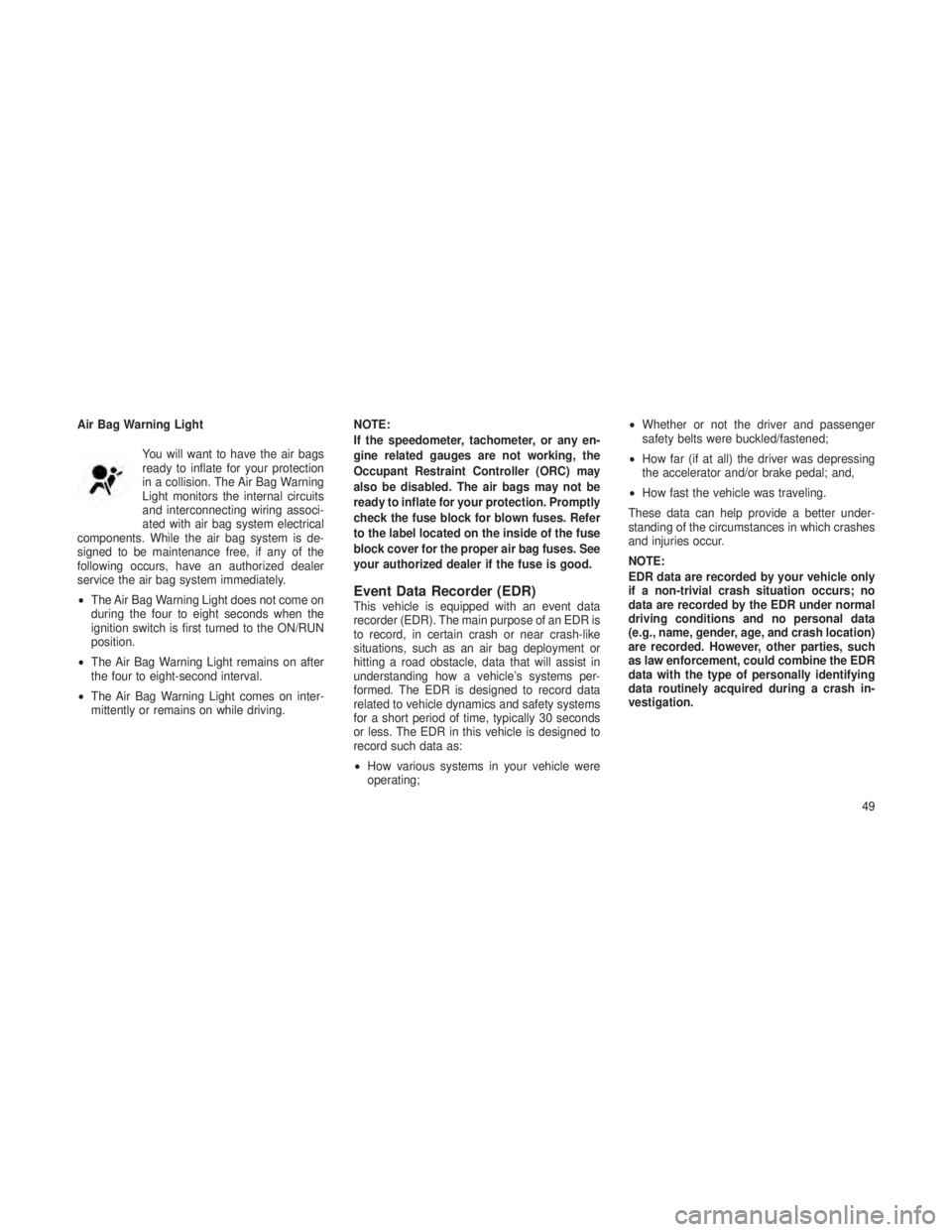
Air Bag Warning LightYou will want to have the air bags
ready to inflate for your protection
in a collision. The Air Bag Warning
Light monitors the internal circuits
and interconnecting wiring associ-
ated with air bag system electrical
components. While the air bag system is de-
signed to be maintenance free, if any of the
following occurs, have an authorized dealer
service the air bag system immediately.
• The Air Bag Warning Light does not come on
during the four to eight seconds when the
ignition switch is first turned to the ON/RUN
position.
• The Air Bag Warning Light remains on after
the four to eight-second interval.
• The Air Bag Warning Light comes on inter-
mittently or remains on while driving. NOTE:
If the speedometer, tachometer, or any en-
gine related gauges are not working, the
Occupant Restraint Controller (ORC) may
also be disabled. The air bags may not be
ready to inflate for your protection. Promptly
check the fuse block for blown fuses. Refer
to the label located on the inside of the fuse
block cover for the proper air bag fuses. See
your authorized dealer if the fuse is good.
Event Data Recorder (EDR)This vehicle is equipped with an event data
recorder (EDR). The main purpose of an EDR is
to record, in certain crash or near crash-like
situations, such as an air bag deployment or
hitting a road obstacle, data that will assist in
understanding how a vehicle’s systems per-
formed. The EDR is designed to record data
related to vehicle dynamics and safety systems
for a short period of time, typically 30 seconds
or less. The EDR in this vehicle is designed to
record such data as:
•
How various systems in your vehicle were
operating; •
Whether or not the driver and passenger
safety belts were buckled/fastened;
• How far (if at all) the driver was depressing
the accelerator and/or brake pedal; and,
• How fast the vehicle was traveling.
These data can help provide a better under-
standing of the circumstances in which crashes
and injuries occur.
NOTE:
EDR data are recorded by your vehicle only
if a non-trivial crash situation occurs; no
data are recorded by the EDR under normal
driving conditions and no personal data
(e.g., name, gender, age, and crash location)
are recorded. However, other parties, such
as law enforcement, could combine the EDR
data with the type of personally identifying
data routinely acquired during a crash in-
vestigation.
49
Page 68 of 408
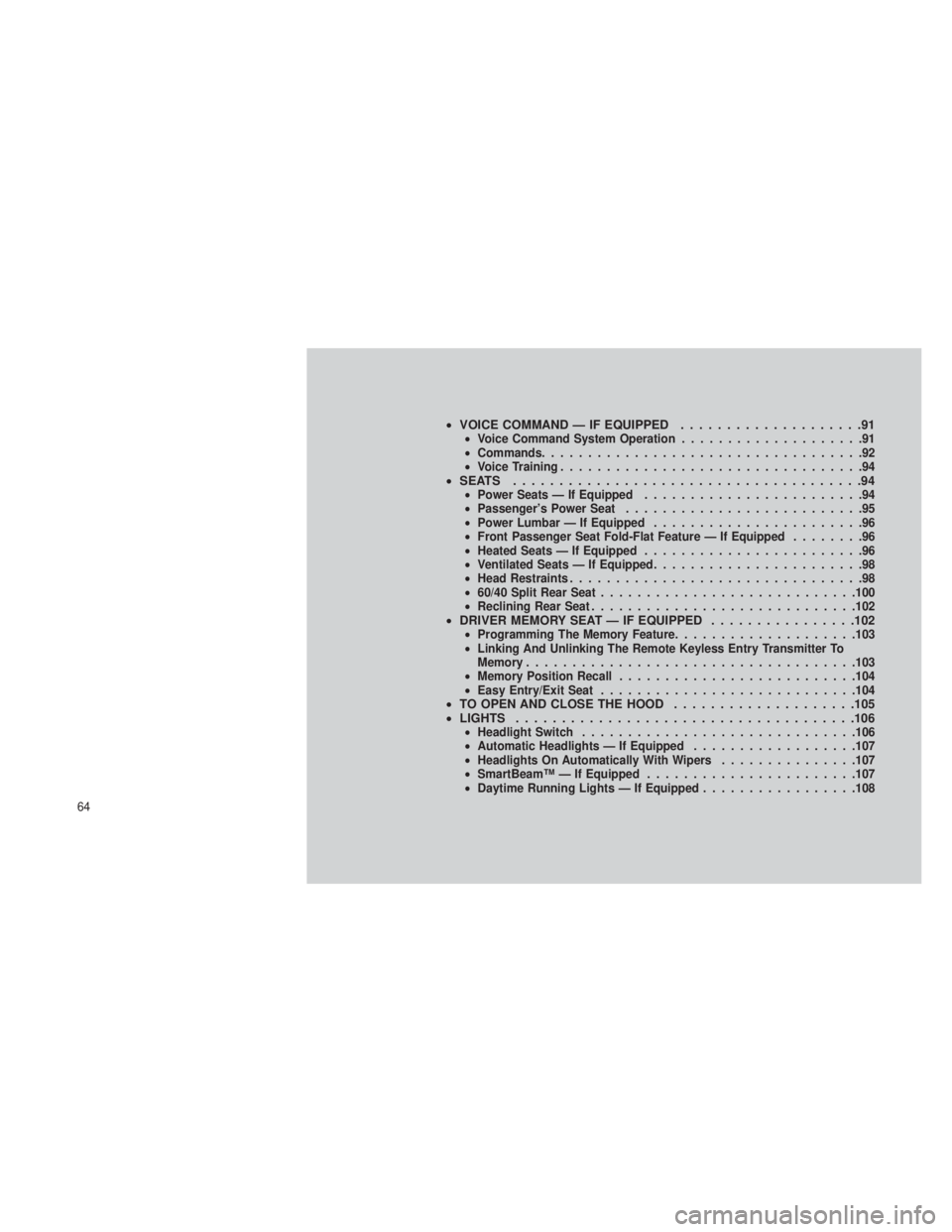
•VOICE COMMAND — IF EQUIPPED ....................91•Voice Command System Operation ....................91
• Commands ...................................92
• Voice Training .................................94
•SEATS ......................................94•Power Seats — If Equipped ........................94
• Passenger’s Power Seat ..........................95
• Power Lumbar — If Equipped .......................96
• Front Passenger Seat Fold-Flat Feature — If Equipped ........96
• Heated Seats — If Equipped ........................96
• Ventilated Seats — If Equipped .......................98
• Head Restraints ................................98
• 60/40 Split Rear Seat ........................... .100
• Reclining Rear Seat ............................ .102
•DRIVER MEMORY SEAT — IF EQUIPPED ................102•Programming The Memory Feature ....................103
• Linking And Unlinking The Remote Keyless Entry Transmitter To
Memory ................................... .103
• Memory Position Recall ......................... .104
• Easy Entry/Exit Seat ........................... .104
•TO OPEN AND CLOSE THE HOOD ....................105
• LIGHTS .....................................106
•Headlight Switch ............................. .106
• Automatic Headlights — If Equipped ..................107
• Headlights On Automatically With Wipers ...............107
• SmartBeam™ — If Equipped ...................... .107
• Daytime Running Lights — If Equipped .................108
64
Page 242 of 408
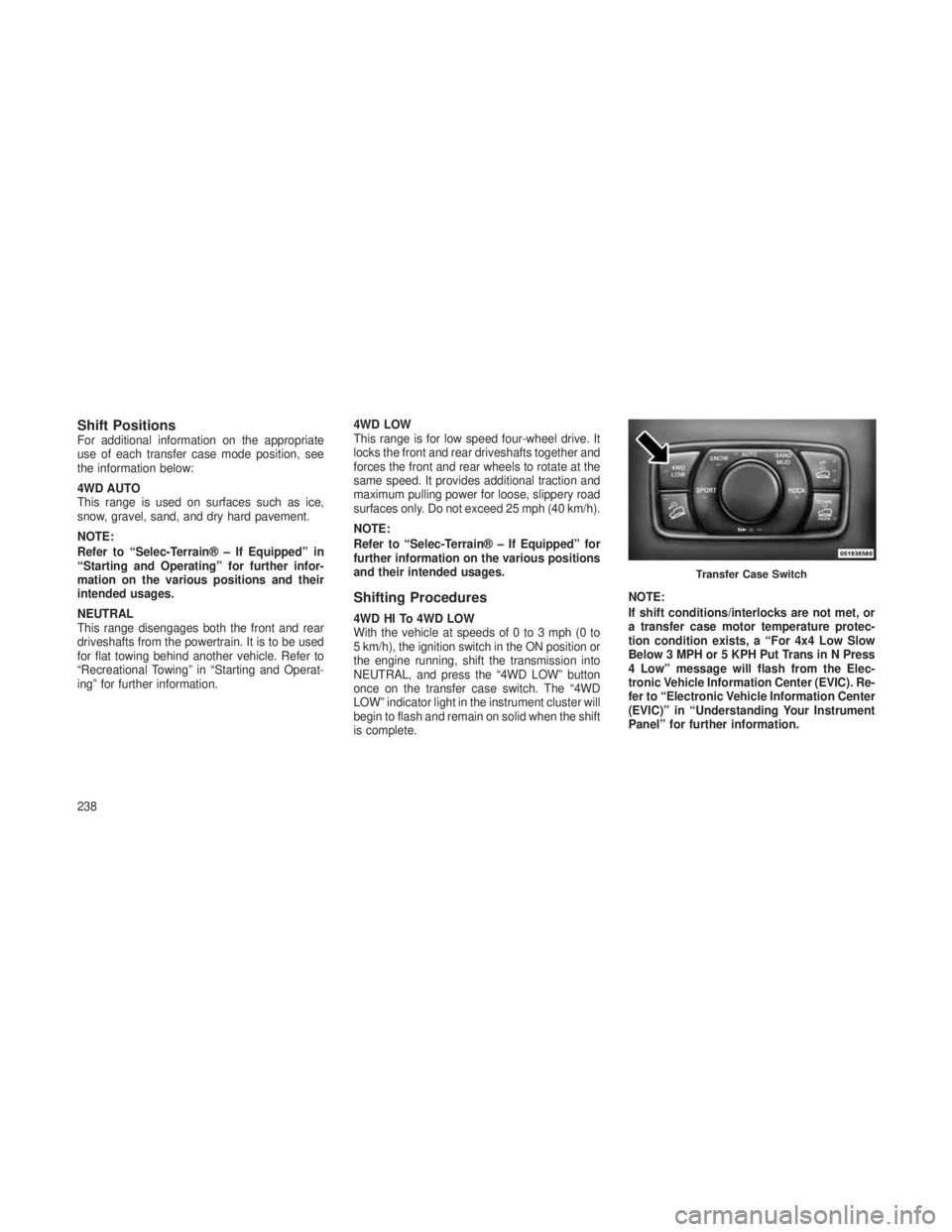
Shift PositionsFor additional information on the appropriate
use of each transfer case mode position, see
the information below:
4WD AUTO
This range is used on surfaces such as ice,
snow, gravel, sand, and dry hard pavement.
NOTE:
Refer to “Selec-Terrain® – If Equipped” in
“Starting and Operating” for further infor-
mation on the various positions and their
intended usages.
NEUTRAL
This range disengages both the front and rear
driveshafts from the powertrain. It is to be used
for flat towing behind another vehicle. Refer to
“Recreational Towing” in “Starting and Operat-
ing” for further information.4WD LOW
This range is for low speed four-wheel drive. It
locks the front and rear driveshafts together and
forces the front and rear wheels to rotate at the
same speed. It provides additional traction and
maximum pulling power for loose, slippery road
surfaces only. Do not exceed 25 mph (40 km/h).
NOTE:
Refer to “Selec-Terrain® – If Equipped” for
further information on the various positions
and their intended usages.
Shifting Procedures
4WD HI To 4WD LOW
With the vehicle at speeds of 0 to 3 mph (0 to
5 km/h), the ignition switch in the ON position or
the engine running, shift the transmission into
NEUTRAL, and press the “4WD LOW” button
once on the transfer case switch. The “4WD
LOW” indicator light in the instrument cluster will
begin to flash and remain on solid when the shift
is complete.
NOTE:
If shift conditions/interlocks are not met, or
a transfer case motor temperature protec-
tion condition exists, a “For 4x4 Low Slow
Below 3 MPH or 5 KPH Put Trans in N Press
4 Low” message will flash from the Elec-
tronic Vehicle Information Center (EVIC). Re-
fer to “Electronic Vehicle Information Center
(EVIC)” in “Understanding Your Instrument
Panel” for further information.
Transfer Case Switch
238
Page 291 of 408
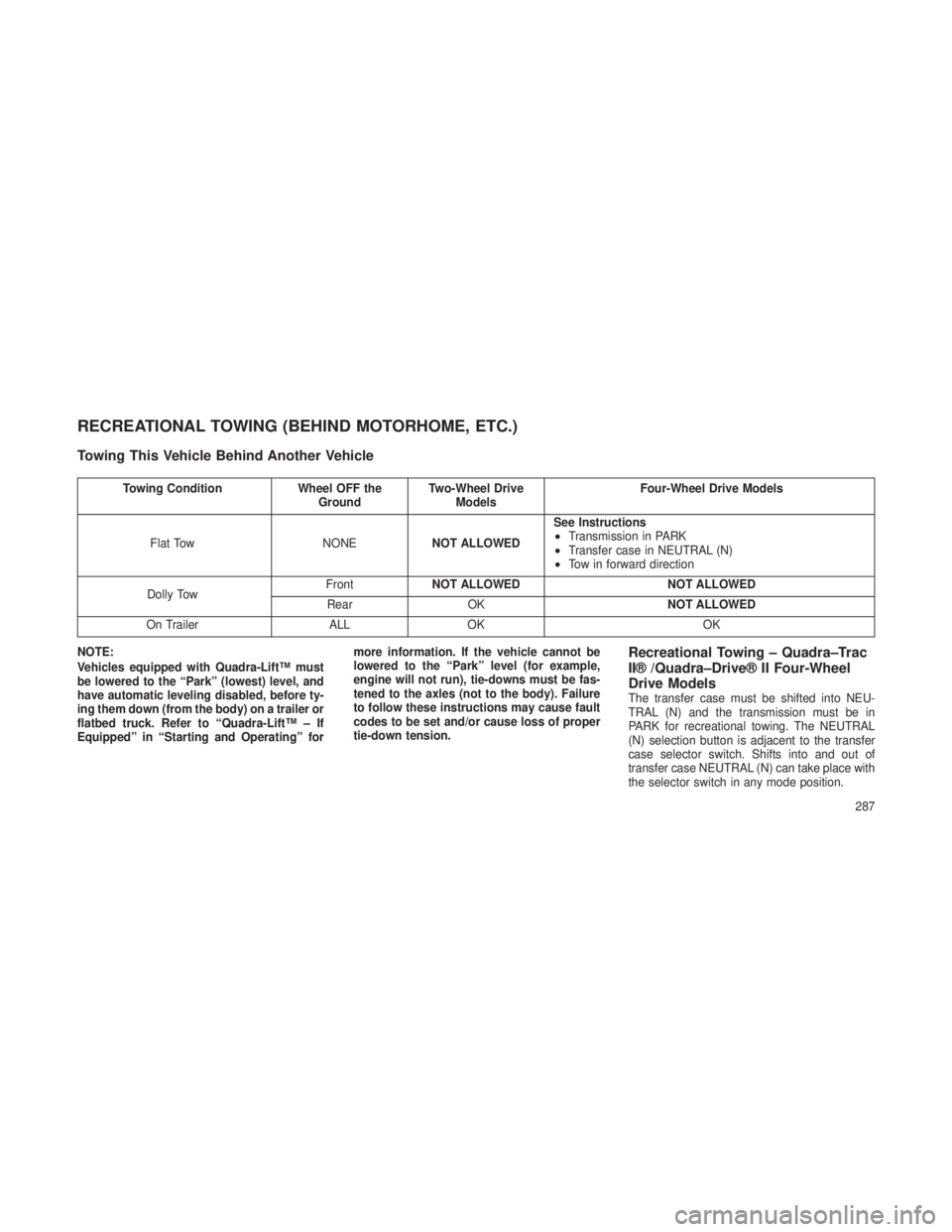
RECREATIONAL TOWING (BEHIND MOTORHOME, ETC.)
Towing This Vehicle Behind Another Vehicle
Towing ConditionWheel OFF the
Ground Two-Wheel Drive
Models Four-Wheel Drive Models
Flat Tow NONENOT ALLOWED See Instructions
•Transmission in PARK•Transfer case in NEUTRAL (N)•Tow in forward direction
Dolly Tow Front
NOT ALLOWED NOT ALLOWED
Rear OK NOT ALLOWED
On Trailer ALLOK OK
NOTE:
Vehicles equipped with Quadra-Lift™ must
be lowered to the “Park” (lowest) level, and
have automatic leveling disabled, before ty-
ing them down (from the body) on a trailer or
flatbed truck. Refer to “Quadra-Lift™ – If
Equipped” in “Starting and Operating” for more information. If the vehicle cannot be
lowered to the “Park” level (for example,
engine will not run), tie-downs must be fas-
tened to the axles (not to the body). Failure
to follow these instructions may cause fault
codes to be set and/or cause loss of proper
tie-down tension.
Recreational Towing – Quadra–Trac
II® /Quadra–Drive® II Four-Wheel
Drive Models
The transfer case must be shifted into NEU-
TRAL (N) and the transmission must be in
PARK for recreational towing. The NEUTRAL
(N) selection button is adjacent to the transfer
case selector switch. Shifts into and out of
transfer case NEUTRAL (N) can take place with
the selector switch in any mode position.
287
Page 300 of 408
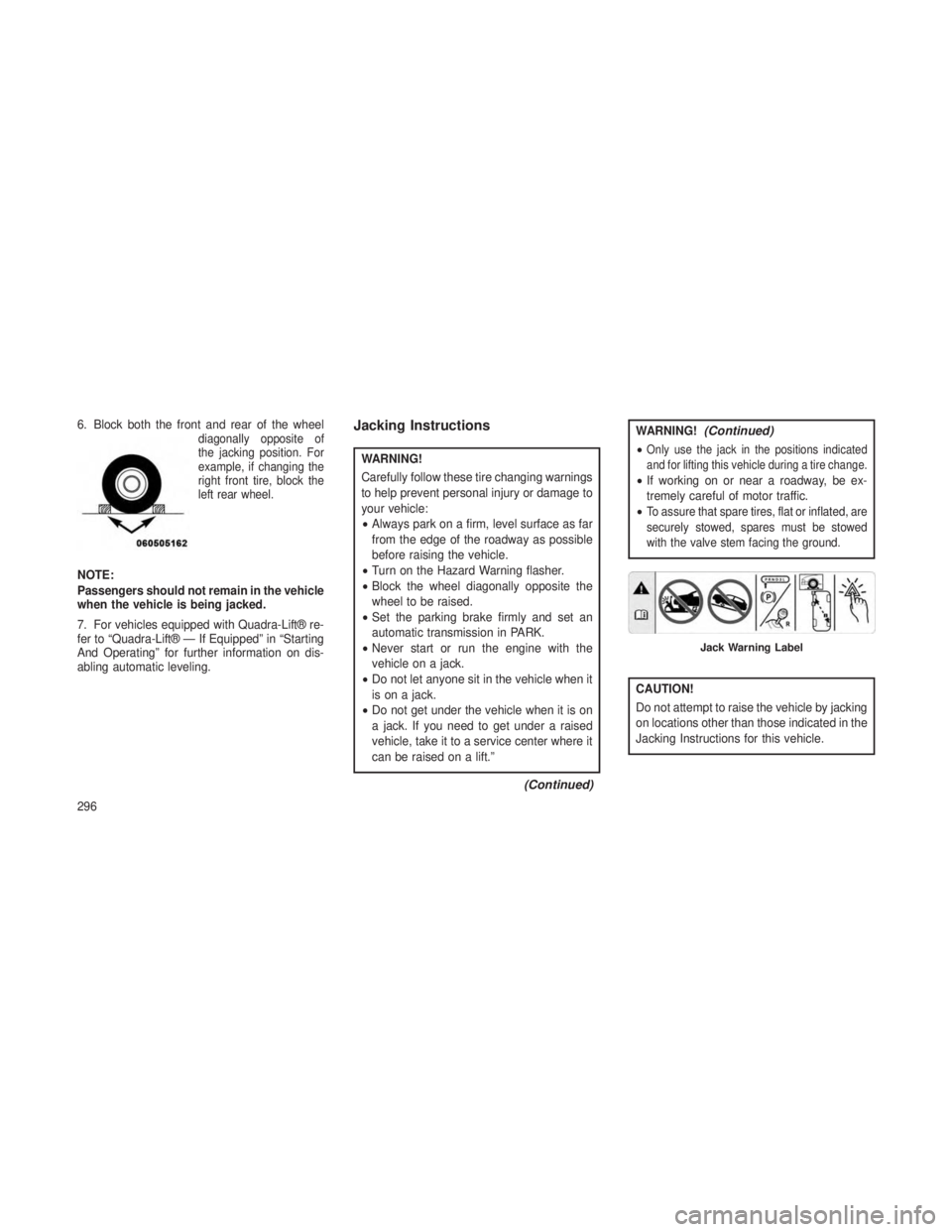
6. Block both the front and rear of the wheeldiagonally opposite of
the jacking position. For
example, if changing the
right front tire, block the
left rear wheel.
NOTE:
Passengers should not remain in the vehicle
when the vehicle is being jacked.
7. For vehicles equipped with Quadra-Lift® re-
fer to “Quadra-Lift® — If Equipped” in “Starting
And Operating” for further information on dis-
abling automatic leveling.
Jacking Instructions
WARNING!
Carefully follow these tire changing warnings
to help prevent personal injury or damage to
your vehicle:
•Always park on a firm, level surface as far
from the edge of the roadway as possible
before raising the vehicle.
• Turn on the Hazard Warning flasher.
• Block the wheel diagonally opposite the
wheel to be raised.
• Set the parking brake firmly and set an
automatic transmission in PARK.
• Never start or run the engine with the
vehicle on a jack.
• Do not let anyone sit in the vehicle when it
is on a jack.
• Do not get under the vehicle when it is on
a jack. If you need to get under a raised
vehicle, take it to a service center where it
can be raised on a lift.”
(Continued)
WARNING!(Continued)
•Only use the jack in the positions indicated
and for lifting this vehicle during a tire change.
•If working on or near a roadway, be ex-
tremely careful of motor traffic.
•
To assure that spare tires, flat or inflated, are
securely stowed, spares must be stowed
with the valve stem facing the ground.
CAUTION!
Do not attempt to raise the vehicle by jacking
on locations other than those indicated in the
Jacking Instructions for this vehicle.
Jack Warning Label
296
Page 308 of 408
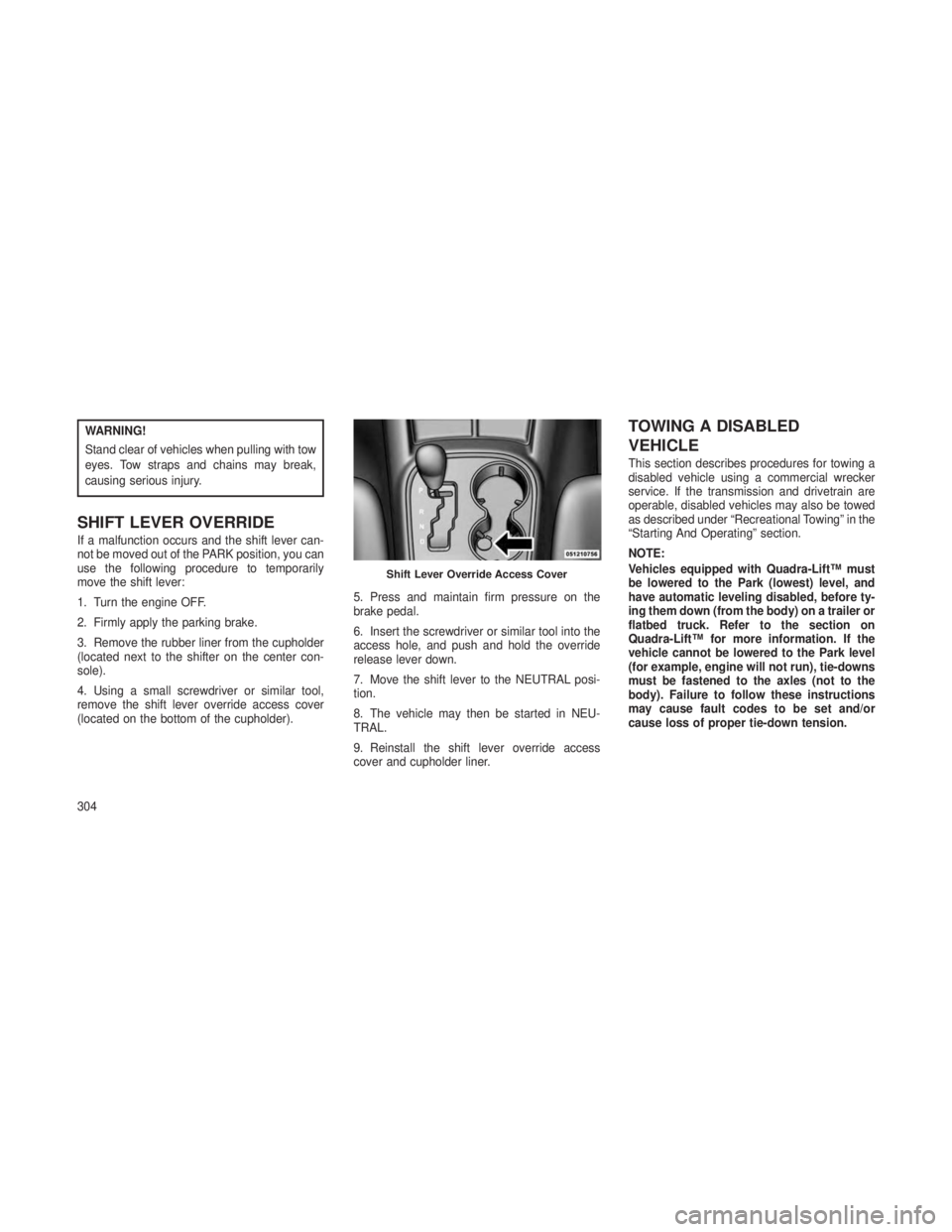
WARNING!
Stand clear of vehicles when pulling with tow
eyes. Tow straps and chains may break,
causing serious injury.
SHIFT LEVER OVERRIDE
If a malfunction occurs and the shift lever can-
not be moved out of the PARK position, you can
use the following procedure to temporarily
move the shift lever:
1. Turn the engine OFF.
2. Firmly apply the parking brake.
3. Remove the rubber liner from the cupholder
(located next to the shifter on the center con-
sole).
4. Using a small screwdriver or similar tool,
remove the shift lever override access cover
(located on the bottom of the cupholder).5. Press and maintain firm pressure on the
brake pedal.
6. Insert the screwdriver or similar tool into the
access hole, and push and hold the override
release lever down.
7. Move the shift lever to the NEUTRAL posi-
tion.
8. The vehicle may then be started in NEU-
TRAL.
9. Reinstall the shift lever override access
cover and cupholder liner.
TOWING A DISABLED
VEHICLE
This section describes procedures for towing a
disabled vehicle using a commercial wrecker
service. If the transmission and drivetrain are
operable, disabled vehicles may also be towed
as described under “Recreational Towing” in the
“Starting And Operating” section.
NOTE:
Vehicles equipped with Quadra-Lift™ must
be lowered to the Park (lowest) level, and
have automatic leveling disabled, before ty-
ing them down (from the body) on a trailer or
flatbed truck. Refer to the section on
Quadra-Lift™ for more information. If the
vehicle cannot be lowered to the Park level
(for example, engine will not run), tie-downs
must be fastened to the axles (not to the
body). Failure to follow these instructions
may cause fault codes to be set and/or
cause loss of proper tie-down tension.
Shift Lever Override Access Cover
304
Page 309 of 408
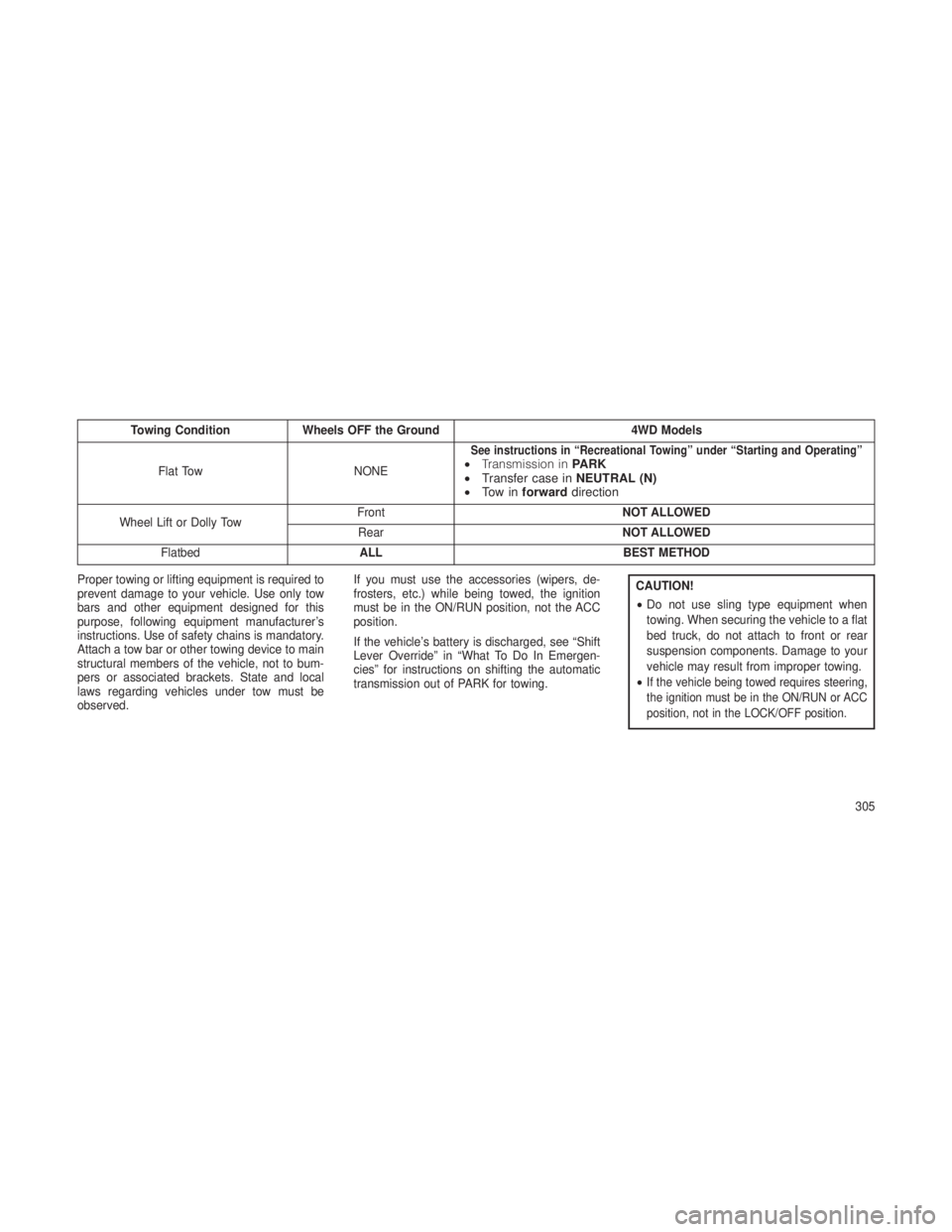
Towing ConditionWheels OFF the Ground 4WD Models
Flat Tow NONE
See instructions in “Recreational Towing” under “Starting and Operating”•Transmission in PARK
• Transfer case in NEUTRAL (N)
• To w i n forward direction
Wheel Lift or Dolly Tow Front
NOT ALLOWED
Rear NOT ALLOWED
Flatbed ALL BEST METHOD
Proper towing or lifting equipment is required to
prevent damage to your vehicle. Use only tow
bars and other equipment designed for this
purpose, following equipment manufacturer’s
instructions. Use of safety chains is mandatory.
Attach a tow bar or other towing device to main
structural members of the vehicle, not to bum-
pers or associated brackets. State and local
laws regarding vehicles under tow must be
observed. If you must use the accessories (wipers, de-
frosters, etc.) while being towed, the ignition
must be in the ON/RUN position, not the ACC
position.
If the vehicle’s battery is discharged, see “Shift
Lever Override” in “What To Do In Emergen-
cies” for instructions on shifting the automatic
transmission out of PARK for towing.
CAUTION!
•
Do not use sling type equipment when
towing. When securing the vehicle to a flat
bed truck, do not attach to front or rear
suspension components. Damage to your
vehicle may result from improper towing.
•
If the vehicle being towed requires steering,
the ignition must be in the ON/RUN or ACC
position, not in the LOCK/OFF position.
305